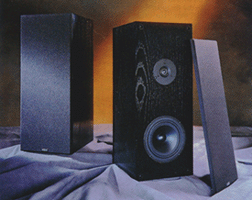B-STOCK SALE! |
Discontinued
The following loudspeakers have been discontinued:
Model 5, Model 7, Model 5SE, Model 10, Model 12, Model 60M, Model 50, Model 25.
To read more about them scroll down.
Please see recommended alternative Role Audio products.
MODEL 5

The Model 5 for music and theater
Perfectly time coherent for music and theater.
Recommended replacement: Role Audio Skiff
"...they seemed to image like a hologram."
(Soundstage.com)
" These speakers actually "blend" with my sub so well, it is down right spooky."
"These are the best small speakers I have found for under $1000. "
(firebirdTN, audioreview.com)
"Once I installed the NSMs (in basically the exact same location as my Quintets were), it sounded absolutely AMAZING. Not only are movies OUTSTANDING, but music is VERY VERY VERY GOOD as well. ...Anyway, I am EXTREMELY pleased with the results. Actually, I do not think...I take that back...I KNOW I could NOT have found a better speaker for the size or price of the Model 5s."
"Their ability to unravel detail, particularly through the midrange, is excellent and easily on par with speakers that cost $1000 or more."
"I found out quickly that thee Model 5s can do extremely impressive bass for its size..."
"...the drums, guitar and vocals all had body and size, proof to me that image size does not necessarily correlate with speaker size."
"..vocals were cast so rock-solid in the center that I placed it among the best I've heard at any price."
"I was left shaking my heat at the fact that such big sound came from such little boxes."
"...they were shocking in their ability to fill
my moderately sized 12' by 16' room with sound..."
(Soundstage.com)
"NSMT Model 5 ... shoots images in the room like a laser and beats out just about any speakers in this regard."
(From Soundstage.com review of CHS-2/W-2 Loudspeaker System)
"... the smallest speaker I know of which can easily be paired with a subwoofer without having to set the crossover to the sub so high in frequency as to make placement problematic." (From forum.ecoustics.com)
"The only speaker I could find that could cast a more rock-solid center image is the utterly minuscule, stupidly-good-at-the-price, ... NSMT Model 5, which shoots images in the room like a laser and beats out just about any speakers in this regard. The little NSMT presents center-placed vocal images as if they are right THERE, like a softball hovering in the air. It's almost eerie and, no doubt, the Model 5's fit-in-the-palm-of-your-hand size helps."
(From Soundstage.com 1999 review of CHS-2/W-2 Loudspeaker System)
"...exudes thoughtful design and craftsmanship."
"...the Model 5s have an easy and expansive sound."
"...the NSMT M5s are about as spatially precise as can be achieved."
(Ultralinear.net 2005 review)
SPECIFICATIONS:
Dimensions: 5.5 X 8 X 6 (W x H x D)
Frequency Response: 65Hz-20kHz,+/- 3dB
-6dB referenced to 1kHz: 58Hz.
Sensitivity: 85dB 1/watt/m
Rated Impedance: 8 ohms
Cabinet construction: half inch MDF
Finish: satin black lacquer
Weight: 7 pounds each
The Mode 5 Signature Edition is a hot rod version of the Model 5. The cabinet is a hand rubbed white Russian Baltic birch plywood cabinet, long known for its anti-resonant properties and sonic quality. The Model 5 SE is hot rodded with Superior (TM) binding posts, polypropelene capacitor by-passed with film foil capacitor, metal oxide resistor, and DH Labs silver sonic internal wire. Imagine sound, imaging, and soundstaging even more exquisite than that of the standard Model 5.
MODEL 5SE
Recommended replacement: Role Audio Skiff
The Mode 5 Signature Edition is a hot rod version of the Model 5. The cabinet is a hand rubbed white Russian Baltic birch plywood cabinet, long known for its anti-resonant properties and sonic quality. The Model 5 SE is hot rodded with Superior (TM) binding posts, polypropelene capacitor by-passed with film foil capacitor, metal oxide resistor, and DH Labs silver sonic internal wire. Imagine sound, imaging, and soundstaging even more exquisite than that of the standard Model 5.
Model 5 SE
Russian Baltic birch plywood hot rod version of the Model 5 optimized for even greater imaging and soundstaging!
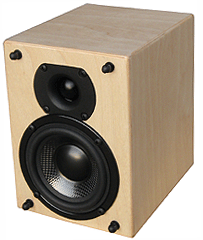
"...the NSMT 5s can create as much quality bass as can be accommodated in a room where they are likely to be used."
(from Ultralinear review of standard Model 5)
"The 5's did not just fill the room &they were very able to drive me out with a few ticks on the volume control of a pretty modest amplifier. And up to the physical limits of their drivers did a Brobdingnagian job of rockin' the room."
"... smooth, open sounding, with the ability to throw a surprisingly stable and deep soundstage."
"... they image like crazy."
"These guys know how to make small speakers work in a way few others approach."
(From review of Model 5SE and EXP by Positive Feedback Online, 2008)
"...they seemed to image like a hologram."
(from Soundstage.com review of standard Model 5)
"This is a serious little speaker."
(From review of Model 5SE and EXP by Positive Feedback Online, 2008)
"... they are remarkably inexpensive for what they do&which is to produce great sound, lots of it, all from a footprint you can put just about anywhere."
"I was really shocked with these little darlings, first because little speakers generally sound &well, little. Also, most often they are way-peaky with pesky frequency dips and valleys a Sherpa would find daunting &and of course, the big bear &no bass ¬ even enough to mate effectively with a sub. The NSMT Model 5-SE is the first truly tiny speaker I have heard to avoid these common pitfalls."
(From review of Model 5SE and EXP by Positive Feedback Online, 2008)

"Their ability to unravel detail, particularly through the midrange, is excellent and easily on par with speakers that cost $1000 or more."
"I found out quickly that thee Model 5s can do extremely impressive bass for its size..."
"...the drums, guitar and vocals all had body and size, proof to me that image size does not necessarily correlate with speaker size."
(from Soundstage.com review of standard Model 5)
"..vocals were cast so rock-solid in the center that I placed it among the best I've heard at any price."
"I was left shaking my heat at the fact that such big sound came from such little boxes."
"...they were shocking in their ability to fill my moderately sized 12' by 16' room with sound..."
(from Soundstage.com review of standard Model 5)
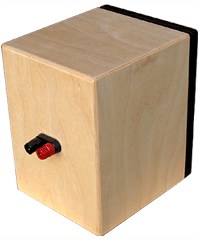
SPECIAL FEATURES:
Magnetically shielded
Time Coherent
Point Source
Design: time-aligned, two-way, first-order, point source, acoustic suspension
Drivers: 1 inch soft dome, ferro-cooled tweeter, 4.5 inch carbon fiber full-range driver
Crossovers: 18 AWG laminated copper inductor, polypropelene capacitor by-passed with film-foil capacitor, metal oxide resistor, DH Labs silver plated copper wire to the tweeter, and oxygen free multi-strand copper wire to the woofer, inductor is wired directly between full-range driver and terminal.Then we outfit the Model 5SE with the Superior (TM) five-way binding posts, some of the finest in the industry.
Cabinet: acoustic suspension
Connectors: gold plated five-way binding posts
10-year limited warranty
SPECIFICATIONS:
Dimensions: 5.5 X 7.5 X 6 (W x H x D)
Frequency Response: 65Hz-20kHz,+/- 3dB
-6dB referenced to 1kHz: 58Hz.
Sensitivity: 85dB 1/watt/m
Rated Impedance: 8 ohms
Cabinet construction: half inch Russian Baltic white birch plywood
Finish: Certified "green" eco-friendly finish allows you to get close to your speaker by limiting off-gassing from plywood or MDF used to make speakers - natural hand rubbed finish look
Weight: 7 pounds each
MODEL 7/7C

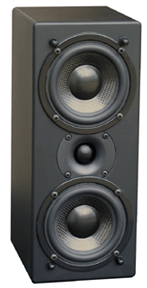
Want the output of a larger loudspeaker with 6.5 inch woofer in a very small package? Need a center channel loudspeaker? Try our Model 7. It is cut from the same cloth as the Model 5.
Suggested replacement: Role Audio DIscovery
Time Coherent A/V monitor and Center Channel Loudspeaker
with twice the out put of the Model 5 and all the Model 5's endearing characteristics
The Model 7/7c is perfectly time coherent. The group delay between the woofer and tweeter is 1/100 of a millisecond!
GET CLOSE TO YOUR MUSIC!
We have redesigned the Model 7, for better imaging performance mainly by reducing the width of the cabinet from 5.5 to 5 inches. The Model 7/7C is a two-way full-range, magnetically shielded, MTM loudspeaker that is designed to produce smooth non-fatiguing, musical sound for use in contemporary stereo or theater systems. A very neutral midrange makes it ideal for use as a center channel. The new narrow profile and small size makes it an excellent match for today's LCD and Plasma TV monitors when used as a center channel or main speaker. Twin high excursion full-range drivers allow it to provide tremendous, coherent output, considering its small size. It features highly effective shielding which allows it to be placed close to, or directly on, CRT enclosures.The narrow-profile cabinet features smooth, rounded corners and a high quality satin black lacquer finish to complement almost any decor.
It uses two high quality four and a half inch long-throw woven carbon fiber full range drivers and an excellent horn loaded soft dome tweeter in the woofer-tweeter-woofer configuration and an acoustic suspension design for superb reproduction of the recorded soundstage. It is a point source, time coherent design with a true first order minimum phase crossover for accurate musical response.
SPECIAL FEATURES:
Magnetically shielded
Design: time-aligned, MTM two-way, first-order, point source, acoustic suspension
Drivers: Drivers: 1 inch soft dome, ferro-cooled tweeter, two 4.5 inch carbon fiber full-range drivers
Crossovers: first-order, 18 AWG laminated copper inductor, polypropeline capacitor, non-inductive wire wound resistor,multi-strand copper to tweeter, inductor is wired directly between full-range drivers and terminal.
Wiring: multi strand copper wire to tweeter and 4.5 inch full-range drivers
Cabinet: acoustic suspension
Connectors: five-way gold plated binding posts
10-year limited warranty
SPECIFICATIONS:
Dimensions:
horizontal- 12 X 5 X 6.5
vertical- 5 X 12 X 6.5 (W x H x D)
Frequency Response: 75Hz - 20kHz, +/- 3 dB
-6dB referenced to 1kHz: 65Hz.
Sensitivity: 90 dB 1/watt/m
Rated Impedance: 8 ohms
Cabinet construction: Cross-braced half inch MDF board
Finish: Certified "green" eco-friendly finish allows you to get close to your speaker by limiting off-gassing from plywood or MDF used to make speakers -- satin black lacquer
Weight: 12 pounds each
Recommended amplifier: 25-150 watts

MODEL 12
The Model 12 is now finished with a beautiful certified environmentally-friendly finish to prevent any hazardous off-gassing that can occur from plywooods and MDFs used to make loudspeakers, at no additional cost.
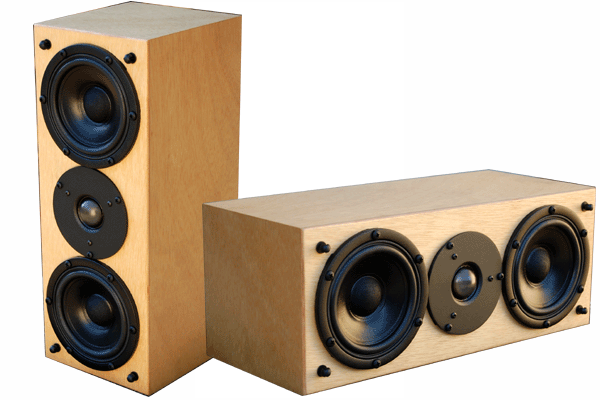
Potent, lush musical performance with extended bass from a compact magnetically shielded loudspeaker that is suitable for stereo and center channel.
The Model 12 uses two five inch SEAS long-throw woofers. Instead of the Morel MDT30 used in the Model 10S, we use the Morel MTD 29 tweeter,another excellent soft dome tweeter from Morel that facilitates in-house high quality magnetic shielding of all the drivers used in the Model 12. The acoustic suspension design of the Model 10S is retained for superb reproduction of the recorded soundstage. And like the Model 10S, the Model 12's crossovers are true minimum phase designs for accurate musical response and the best transient response.
Suggested replacement: Role Audio Discovery
The 60M
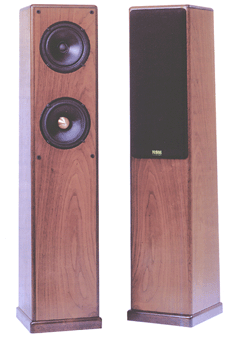
(suggested replacement: Jamaica, Model 100M)
(suggested replacement: Jamaica/Model 50)
MODEL 50
Reprinted with permission from
Stereo Review
TEST REPORTS
FEBRUARY 1993JULIAN HIRSCH, HIRSCH-HOUCK LABORATORIES
The NSMTModel 50, despite its conventional appearance, is not just another conventional column loudspeaker. The goal of its designers was to produce a "compact acoustic suspension system with the bass response of a subwoofer, and the imaging and soundstaging of a minimonitor."
To achieve those goals, they located its single 6/2-inch bass driver in a separate sealed subenclosure at the bottom of the cabinet, with heavy bracing to ensure rigidity and damped with open-cell foam and Dacron. At the top of the cabinet they placed another 6l/2 inch cone driver to handle the midbass and midrange frequencies. NSMTdoes not indicate the effective crossover frequency between these drivers, or to the single 1-inch soft-dome tweeter located midway between the two cone speakers.
NSMTstresses the Model 50's imaging characteristics, which are said to be due in part to its minimum-phase crossover network and careful matching of the drivers and crossover component values in each pair of speakers. The Model 50 is sold only in pairs, bearing identical numbers and distinguished by their "A" and "B" designations. The specific component values used in each Pair of speakers are recorded on the production schedule, so that the speakers can readily be restored to their original matched performance in the event of damage. Although NSMTstates that it "breaks in" drivers and matches them before assembly, the owner's manual recommends that the speakers be "broken in" for 200 hours at low to moderate volume to insure the best possible performance.
The upper two-thirds of the front panel is covered by a removable black cloth grille. Near the bottom of the rear panel are two pairs of recessed, gold-plated binding posts, normally joined by gold-plated straps. With the straps removed, the system can be biwired or biamplified.
The Model 50's frequency response is rated as a "room response" of the pair of speakers under specific conditions that do not include the room dimensions; the rating cannot be correlated with any measurements we might be able to make. The sensitivity of each speaker is given as relatively low 85 dB sound-pressure level (SPL) on the tweeter axis at 1 meter with a 1 watt input (presumably the standard 2.83 volts). Unconventionally, the manufacturer gives three impedance ratings: minimum 4 ohms, rated 8 ohms, and "nominal" 16 ohms.
The Model 50's measured sensitivity was 85 dB, exactly as rated. The room response above a few hundred Hertz was very uniform and smooth, with a variation of only +2.5 dB from 300 Hz to 20 kHz. When we measured the quasi-anechoic responses of the two cone drivers, with close microphone spacing, we found that the woofer (lower driver) output reached its maximum at 100 Hz, falling at 12 dB per octave below about 70 Hz and at 6 dB per octave from 100 Hz to 300 Hz. The upper driver (midrange) had a similar response below 100 Hz (about 3 dB lower in level than the lower one), but did not drop off as rapidly at higher frequencies and delivered several times as much power above 500 Hz as did the lower driver. Both drivers appeared to cut off above 3 kHz.
Splicing the woofer curves to the room response to create a composite response was difficult. A reasonable match existed in the range of 300 to 700 Hz, resulting in a composite curve flat within +2.5 dB from 250 Hz to 20 kHz, rising about 6 dB from 250 to 100 Hz, and returning to its midrange level at 45 Hz. Even at 32 Hz, the output was only 6 or 7 dB below the average midrange level, and (as listening confirmed) it was perfectly audible and usable at that frequency.
Quasi-anechoic MLS frequency-response measurements at several different distances from the speaker shared a number of common characteristics. All showed a maximum output at 1.5 to 2 kHz, dropping to a minimum at about 5 kHz, and returning to the 300Hz level (the low-frequency limit of this measurement) at several frequencies between 7 and 20 kHz. Despite these minor variations, typical of most speakers in this sort of measurement,
steeply, to a minimum of 5 ohms at 120 Hz, climbing to a bass resonance of 11 ohms at 65 Hz and dropping to 4.8 ohms at 29 Hz.
We measured the woofer distortion with a 5-volt input (corresponding to our 90-dB reference level for this measurement). From 60 to 220 Hz, it was between 0.55 and 1 percent, rising at lower frequencies to 7.5 percent at 40 Hz and 13 percent at 30 Hz. In the upper part of the woofer's range, the distortion rose to 1.5 percent at 400 Hz and somewhat more at higher frequencies. But it was the upper cone driver, whose output was comparable to that of the lower driver up to about 300 Hz, that dominated the system output above 400 Hz, with a roughly constant distortion level of 1 percent from 300 Hz to 1 kHz and less than 2 percent up to 2.5 kHz, where our measurement stopped.
Reprinted with permission from
Stereo Review
TEST REPORTS
JANUARY 1993
Suggested replacement: The Chorus/Model 25
Finish
Natural oak veneer with tan grille or
black-ash veneer with black grille
stands and positioned them as recommended by the manufacturer. Their room response was exceptionally flat and smooth, varying only + 4 dB from 65 to 20,000 Hz.
A close-miked measurement of the woofer response showed a maximum output between 70 and 170 Hz, falling off at 12 dB per octave at lower frequencies and more gradually at higher frequencies.
Our composite response curve, formed from these two sets of data, was flat within +3 dB from 50 to 20,000 Hz. For most of that range the response was extremely flat, although there were some minor irregularities between 150 and 1,000 Hz.
Response measurements with a stepping one-third-octave band of pink noise were quite similar, within +3 dB from 58 to 20,000 Hz. The tweeter's horizontal directivity was excellent; the on-axis and 45-degree off-axis responses diverged only 2 dB at 7,000 Hz, 3 dB at 10,000 Hz, and 10 dB at 20,000 Hz.
We also attempted frequency-response measurements using the quasianechoic MLS program of our Audio Precision System One test instrument. These confirmed the essential features of the midrange and high-frequency response we had measured previously ( + 2 dB from I ,000 to 20,000 Hz), but they also showed a reduced and irregular output from 500 to 2,000 Hz that was completely inconsistent with what we found in the room-response measurement (or in listening tests), although a somewhat similar effect could be seen in the close-miked woofer measurement. We have no good explanation for this apparent discrepancy, but we are inclined to accept the verdict of our ears and the room measurements, which were consistent with each other.
The speaker's impedance characteristics were quite unusual. For one thing, the minimum impedance, at 138 Hz, was about 9.6 ohms. At other frequencies the impedance varied between 10 and 38 ohms. The woofer's resonance frequency was at 60 Hz. Overall, the phase angle of the impedance varied smoothly between +30 and - 45 degrees, with no evidence of the sharp jogs, indicating resonances in drivers or the enclosure, that we've seen from many speakers in this measurement. The acoustic phase linearity was also good, with a group-delay variation of + 250 microseconds from just over 1,000 Hz up to 20,000 Hz.
<font "="" face="Arial" size="-1">The NSMTModel 25's sensitivity was (as rated) very low, with an output SPL of 81 dB at 1 meter from a 2.83volt input of pink noise. Since our woofer-distortion measurements are based on a nominal 90-dB SPL, we measured distortion at 8 volts input. It was very low, rising from 0.3 to 0.5 percent between 120 and 2,000 Hz to 1 percent between 70 and 100 Hz and 4 percent at 50 Hz. At the system's rated lower limit of 35 Hz, the output was down 10 dB from the upper-midrange average (instead of 3 dB), and the distortion was 20 percent.
The Model 25 was able to handle large input levels in our single-cycle tone-burst tests. At 1,000 and 10,000 Hz, the amplifier clipped at 220 to 240 watts into its 30-ohm impedance. At 100 Hz, the woofer began to sound hard well before its cone reached the
suspension limits, and to avoid possible damage to the speaker, we did not attempt to go higher than about 265 watts into its 11-ohm impedance.
The NSMTModel 25 is not a product that follows all the usual patterns of loudspeaker design. It is one of the few speakers we have tested that gave seemingly irreconcilable results with some of the very different measurement techniques we use (which one would expect to yield fairly similar data). It is also an exception in its very low sensitivity, which makes the 50- to 150-watt amplifier power recommendation one to be taken seriously. The Model 25 requires four to eight times as much power as most other speakers to achieve the same output level.
The Model 25 sounded very easy, clean, and smooth. There was no apparent excess or deficiency in any part of the audio spectrum, and its soundstage was superb. You could not ask for a more listenable speaker, although it is not one that can be used to generate life-like sound levels.
It also did not achieve any miracles in the bass range. The 35-Hz claimed lower limit is unrealistic; a 50-Hz limit would be more accurate and more consistent with the size of the woofer and enclosure. Indeed, NSMTmakes a subwoofer for those who want or need more volume or deeper bass.
But within the limits of what it can do, the NSMTModel 25 is a first-rate speaker whose sound justifies its price. To our ears it sounded as flat and uncolored as our measured response curve implied, which places it in the ranks of some far more expensive, very highly regarded speakers.

